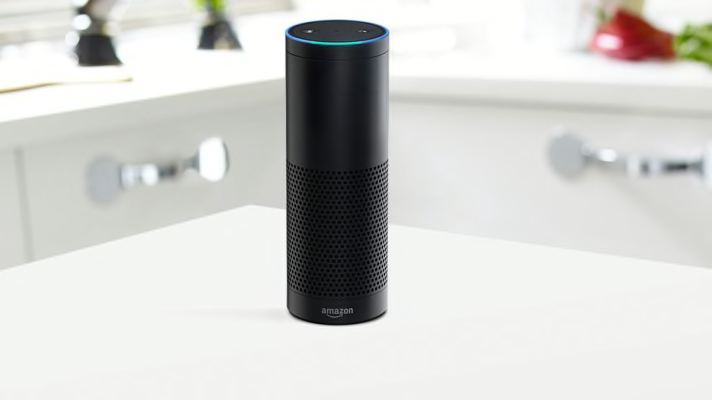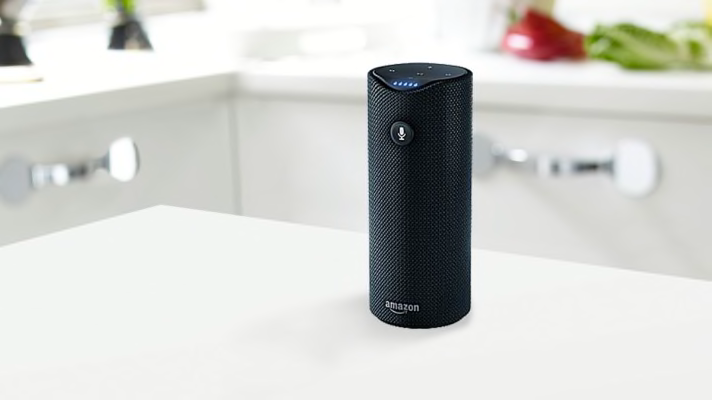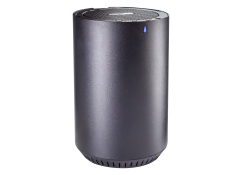Amazon's three Alexa-driven speakers differ in portability and how they connect to other devices. But the voice-activation capability performs the same in each, fetching information from the internet, ordering a pizza, or finding your favorite tunes. Here's a rundown on how they work.
Three Ways to Get Alexa

Amazon Echo
What it is: The original—and best-sounding—speaker in Amazon's Echo family: It earned a Good score in our tests for its sound quality. Interaction with Alexa is conveniently hands-free.
Who it's for: Most Alexa users. Once you set this speaker up, you'll never have to touch it again. In addition to providing Alexa's assistance, the Echo is a decent speaker for enjoying music from Amazon, Spotify, and other streaming services.

Tap
What it is: The most mobile Echo speaker, thanks to a built-in rechargeable battery that Amazon says provides up to 9 hours of service. The Tap lets you switch from WiFi to Bluetooth and use your smartphone's data connection to reach Alexa if you're spending the day at the beach. But sound quality is only Fair in CR's tests, and you have to press a button to engage with Alexa.
Who it's for: Outdoor types who want a portable Bluetooth speaker.

Echo Dot
Price: $90
What it is: A puck-sized device that can be paired with any speaker or audio system via Bluetooth or a stereo jack. The Echo Dot is also a speaker, but it sounds tinny and is meant for providing verbal responses to your questions, not for playing music.
Who it's for: Alexa fans who'd rather hear music through their own audio gear rather than through the Echo. Because of its tiny size, the Dot could also be used in a space unable to accommodate its taller siblings.
Alexa in Action
The Alexa virtual assistant is already handy to have around the house, and new ‘skills' are added to her repertoire almost every day. Here's just a sampling of some of the many things she can do.
Organization
The good: You can use Alexa to set timers and provide verbal calendar reminders for events such as birthdays and dental appointments. You can also dictate lists and later review them on the Alexa app on your smartphone. Alexa links to products such as a Fitbit, so she can tell you how many steps you've walked before you decide on dessert.
The bad: Alexa does not have access to your phone's contacts, and you can't use her to make a speaker phone call. Texting with Alexa is too cumbersome to be practical.
News
The good: It's easy to set up your daily news briefings from sources including the BBC, NPR, the Washington Post, and more. Alexa will even recite your local weather forecast.
The bad: Because she's basically playing a string of podcasts from various news organizations, the briefings really aren't all that brief.
Recipes
The good: Alexa can recite step-by-step recipe instructions from apps such Recipe Buddy and can walk you through how to make any of 12,000 cocktails with an app called The Bartender. You can get her to pause and to repeat each step, and she'll send a copy of the recipe to your phone.
The bad: You can have Alexa repeat steps ad nauseam, but some cooks might find it challenging to perform complex steps without consulting written instructions and illustrations.
Shopping
The good: Alexa is tied to your Amazon account and can capably reorder certain things you've purchased in the past. Just say, "Alexa, reorder paper towels" and she'll fetch another package of Bounty just like the one in your order history.
The bad: She can order only Prime-eligible items, and they can't be apparel, shoes, jewelry, or watches. Also out are items from Amazon Fresh, Prime Pantry, and Prime Now. If you're not reordering an item, you're better off just using your smartphone, tablet, or laptop.
Entertainment
The good: You can ask Alexa to play a wide selection of music, much of it free, from Amazon's Prime music library and from partners such as Pandora and Spotify. You can play your own music if you've uploaded it to Amazon's cloud storage. Alexa plays recorded books from the $15-per-month Audible service; she can also read Kindle e-books in her own voice.
The bad: Alexa's Kindle-book orations sound like a robot reading a random string of words. Stick to the Audible books, which have professional narrators.
Jokes
The good: When you're bored, Alexa can come up with some jokes on the fly, such as this one: "What's worse than finding a worm in an apple? Answer: finding half a worm."
The bad: We're pretty sure we remember that worm joke from a Bazooka Joe bubble gum comic strip in the 1970s, and it was ancient then. (Note: You can find Alexa new material via third-party apps, such as Stupid Musician Jokes.)
Ordering Food
The good: Alexa can order you a pizza from Domino's, saving you the inconvenience of having to put down the remote to pick up your phone.
The bad: She can order only dishes you've saved as an "Easy Order" in your Domino's website account—there's no deciding you want extra cheese on your order, or even a bottle of soda.
Home Control
The good: Say the word and Alexa will adjust your thermostat, open and close your drapes, lock your doors, turn down the lights, and turn up the ceiling fan while you stay comfortably glued to the couch.
The bad: You could go broke replacing or modifying things in your home to make them Alexa-compliant. For instance, smart lightbulbs and electrical receptacles start around $15 and rise sharply; thermostats range from $115 to $250; ceiling fans can cost $500. For certain items, installation adds more to the bill.
Editor's Note: This article also appeared in the September 2016 issue of Consumer Reports magazine.


















